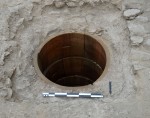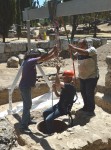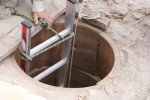Archaeologists have discovered the first ancient oracle of Apollo in Athens. Others have been found elsewhere in Greece, most famously the Oracle of Delphi, but this one is the only discovered in Athens. It’s in Kerameikos — the old potters’ quarter (hence the name) — northwest of the Acropolis in downtown Athens. It’s the site of a necropolis used over different periods known today as the Street of the Tombs for the funerary moments and stelae that line the road to Eleusis where the mysteries were performed.
 Just south of the burial ground is a sanctuary discovered by Kyriakos Mylonas, a pioneer of scientific archaeology in Greece, in 1890. Myolnas unearthed a marble omphalos stone set in a rectangular enclosure between the altar and a triangular statue base in a cult niche. The omphalus, meaning navel, symbolized the center of the world. It was also believed to enable direct communication with the gods. The omphalos stone at the Oracle of Delphi was hollow and is believed to have been part of the ritual reading the oracular gases that came up through it. Because Hecate was frequently depicted as having three forms, Myolnas thought the base once held a statue of Hecate and that the sanctuary was dedicated to her, but Artemis was also sometimes depicted in triplicate, and several inscriptions and other artifacts were later found on the site indicating it was a sanctuary of Artemis Soteira, meaning Artemis the Saviour.
Just south of the burial ground is a sanctuary discovered by Kyriakos Mylonas, a pioneer of scientific archaeology in Greece, in 1890. Myolnas unearthed a marble omphalos stone set in a rectangular enclosure between the altar and a triangular statue base in a cult niche. The omphalus, meaning navel, symbolized the center of the world. It was also believed to enable direct communication with the gods. The omphalos stone at the Oracle of Delphi was hollow and is believed to have been part of the ritual reading the oracular gases that came up through it. Because Hecate was frequently depicted as having three forms, Myolnas thought the base once held a statue of Hecate and that the sanctuary was dedicated to her, but Artemis was also sometimes depicted in triplicate, and several inscriptions and other artifacts were later found on the site indicating it was a sanctuary of Artemis Soteira, meaning Artemis the Saviour.
 In 2012 during some cleaning work on the site, the German Archaeological Institute found that the omphalos was mounted on a marble slab that covered an opening. Last year, the omphalos was raised with a crane to reveal what it had been concealing for thousands of years: a circular well nine meters (30 feet) deep constructed out of semi-cylindrical clay tiles engraved with more than 20 inscriptions of the phrase “ΕΛΘΕ ΜΟΙ Ω ΠΑΙΑΝ ΦΕΡΩΝ ΤΟ ΜΑΝΤEΙΟΝ ΑΛΗΘΕΣ,” which translates to “Come to me, O Paean, and bring with you the true oracle.” Paean was an epithet of Apollo, son of Zeus and brother of Artemis. The repeated phrase was a prayer, an invocation to the deity that he reveal faithful and accurate answers to believers’ questions.
In 2012 during some cleaning work on the site, the German Archaeological Institute found that the omphalos was mounted on a marble slab that covered an opening. Last year, the omphalos was raised with a crane to reveal what it had been concealing for thousands of years: a circular well nine meters (30 feet) deep constructed out of semi-cylindrical clay tiles engraved with more than 20 inscriptions of the phrase “ΕΛΘΕ ΜΟΙ Ω ΠΑΙΑΝ ΦΕΡΩΝ ΤΟ ΜΑΝΤEΙΟΝ ΑΛΗΘΕΣ,” which translates to “Come to me, O Paean, and bring with you the true oracle.” Paean was an epithet of Apollo, son of Zeus and brother of Artemis. The repeated phrase was a prayer, an invocation to the deity that he reveal faithful and accurate answers to believers’ questions.
 The shaft is only about 65 cm in diameter (just over two feet) which makes it a very tight fit for archaeologists to explore. Still, researchers were lowered in cautiously by crane. The style of the inscriptions place them in the Roman period, probably the third century, but the well is likely to have been in place much earlier.
The shaft is only about 65 cm in diameter (just over two feet) which makes it a very tight fit for archaeologists to explore. Still, researchers were lowered in cautiously by crane. The style of the inscriptions place them in the Roman period, probably the third century, but the well is likely to have been in place much earlier.
Though the powers of the oracle at Delphi and others were famously plied by the ancient Greeks, this is the first ancient oracular edifice to Apollo to have been found in Athens itself, Dr. Jutta Stroszeck, director of the Kerameikos excavation on behalf of the German Archaeological Institute at Athens, told Haaretz. The well would have been used for hydromancy, a method of divination by means of water.
The ancients routinely sought oracular guidance not only on the future, for simple everyday matters, such as finding/keeping a lover, ahead of a journey, after falling ill, and so forth – or applying for asylum in the sanctuary.
 This find is also significant because it confirms that the omphalos is in its original location. It is the only one in Greece to bear that distinction. The one in Delphi was moved over the years and is now in an unrelated location inside the sanctuary.
This find is also significant because it confirms that the omphalos is in its original location. It is the only one in Greece to bear that distinction. The one in Delphi was moved over the years and is now in an unrelated location inside the sanctuary.
A wooden lid with a waterproof cover has been placed over the oracle well for its protection. The plan is to move some of the marble pieces, including the omphalos, to the Kerameikos museum. A replica will be placed in the sanctuary so it can take the brunt of the elements while the original is spared.